Avatar: The Way of Water is breathtakingly beautiful but fails the fundamentals
Thirteen years in the making and with outsized expectations, James Cameron’s epic follow-up misses the fundamentals of storytelling.
Movies
Don't miss out on the headlines from Movies. Followed categories will be added to My News.
Did you even know there was another Avatar movie coming? Did you know the plan is for four sequels?
If you haven’t been paying attention, it may all come as a bit of a surprise given it’s been 13 years since James Cameron’s blue aliens, and Avatar hasn’t had the strongest, lasting impact on pop culture as its most ardent fans would argue it did.
Perhaps you haven’t thought about Avatar at all in these intervening years, or perhaps you’ve thought about nothing else. So, the question of “Is the $US350 million Avatar 2 any good or worth watching?” is intrinsically tied to “How much did you like the first movie?”.
Because if you frothed the first Avatar and went back again and again to the cinema to bathe in Cameron’s eye-popping Pandora and the scale and ambition of his movie, then Avatar: The Way of Water is a no-brainer.
But if you thought Avatar was too long, too thin on story and characterisation and that even though it was visually impressive, you’re just not going to put yourself through that again, then Avatar: The Way of Water is a no-brainer – but in a different way.
This sequel will repeat your experience of the first. Déjà vu is real and it has nothing to do with black cats.

It is jaw-droppingly beautiful at times, enough to make you forget you’re watching CGI and not the most stunningly photographed David Attenborough documentary. It can also be achingly boring, is (ironically) shallow and lacks enough story to justify its three hours and 13 minutes runtime.
Returning to Pandora, Jake (Sam Worthington) and Neytiri (Zoe Saldana) are now parents to a brood of kids – oldest son and warrior Neteyam (Jamie Flanders), second son and outsider Lo’ak (Britain Dalton), oldest daughter Kiri (Sigourney Weaver) and youngest Tuk (Trinity Jo-Lo Bliss).
No, that’s not a typo, Weaver provided the performance capture and voice for one of Sully and Neytiri’s kids, and her connection to Weaver’s original character Grace is dismissed as “mysterious”. It may come into play in a later sequel but for now you have to just go with it.
The Sullys are driven from their forest home when an old foe, the sky people (humans), rain down fire from above and re-colonise parts of the planet. Chief among the antagonists is the villainous Quaritch (Stephen Lang), whose human form is very much dead but whose consciousness has now been transferred into a Na’vi avatar.

Quaritch is just as roll-your-eyes one-dimensional and bluster as before, with a small late-in-the-game equivocation that still doesn’t make him interesting. When there are so many multilayered villains in big studio blockbusters, Quaritch’s cartoonish bad guy is just lazy writing.
Fleeing from their home in a bid to protect the others, the Sullys seek refuge with the Metkayina clans, who make their home among the reef archipelagos of Pandora. They’re physically distinct with their webbed feet and tails and more fin-like arms, helping them to glide through water with ease.
The Sullys are taken in by chief Tonowari (Cliff Curtis) and his wife Ronal (Kate Winslet), but there is scepticism among the Metkayina that these forest-dwellers can adapt to their way of life. Plus, there’s the threat of Quatritch’s dogged pursuit of Sully in revenge for his death.
The Sully kids take centre stage as the story shifts focus to them, trying to fit in with Tonowari’s kids, trying to become part of the wondrous underwater world.
These scenes of discovery and exploration are what makes Avatar: The Way of Water at times breathtaking. How Cameron and his team have rendered CGI water and the interaction between the Na’vi and the undersea creatures are truly magnificent.
It’s so vivid and enthralling, and it makes you appreciate the level of craft and dedication that went on behind the scenes. The actors, including the child ones, learnt to free dive and hold their breath so the crew could capture all their performances underwater.
Winslet broke a record and did it for seven minutes – even if her talent and presence was actually wasted overall.

While the ambition was there, and you can see the emotions etched across the face of each Na’vi character, it doesn’t change the fact that the script was both overwritten and underwritten, which makes it difficult to invest in any of the characters.
The dialogue is clunky and feels compelled to spell out the most obvious beats while no one is particularly well-developed – any argument that characters will be shaded in in subsequent sequels doesn’t change the fact it didn’t do the work here, and it had surplus time to do it.
And the story is a simple chase plot, merely a template to do what Cameron seems more intent on achieving, which is seeing just how far he can push the technological and visual aspects of filmmaking.
But that’s not enough. You can appreciate Avatar: The Way of Water for its craft, you can be in awe of its scale but that doesn’t hide what it lacks in the fundamentals of storytelling – and when it’s asking a lot of its audience, it needed to nail those non-negotiables.
The 3D visuals are undoubtedly cool but it shouldn’t be the only reason to see this film.
It’s all sheen and spectacle, so for a movie about the emotional depths between the Na’vi and their environment, it’s frustratingly all surface.
Rating: 2.5/5
Avatar: The Way of Water is in cinemas from Thursday, December 15 with previews on Wednesday evening
More Coverage
Originally published as Avatar: The Way of Water is breathtakingly beautiful but fails the fundamentals





